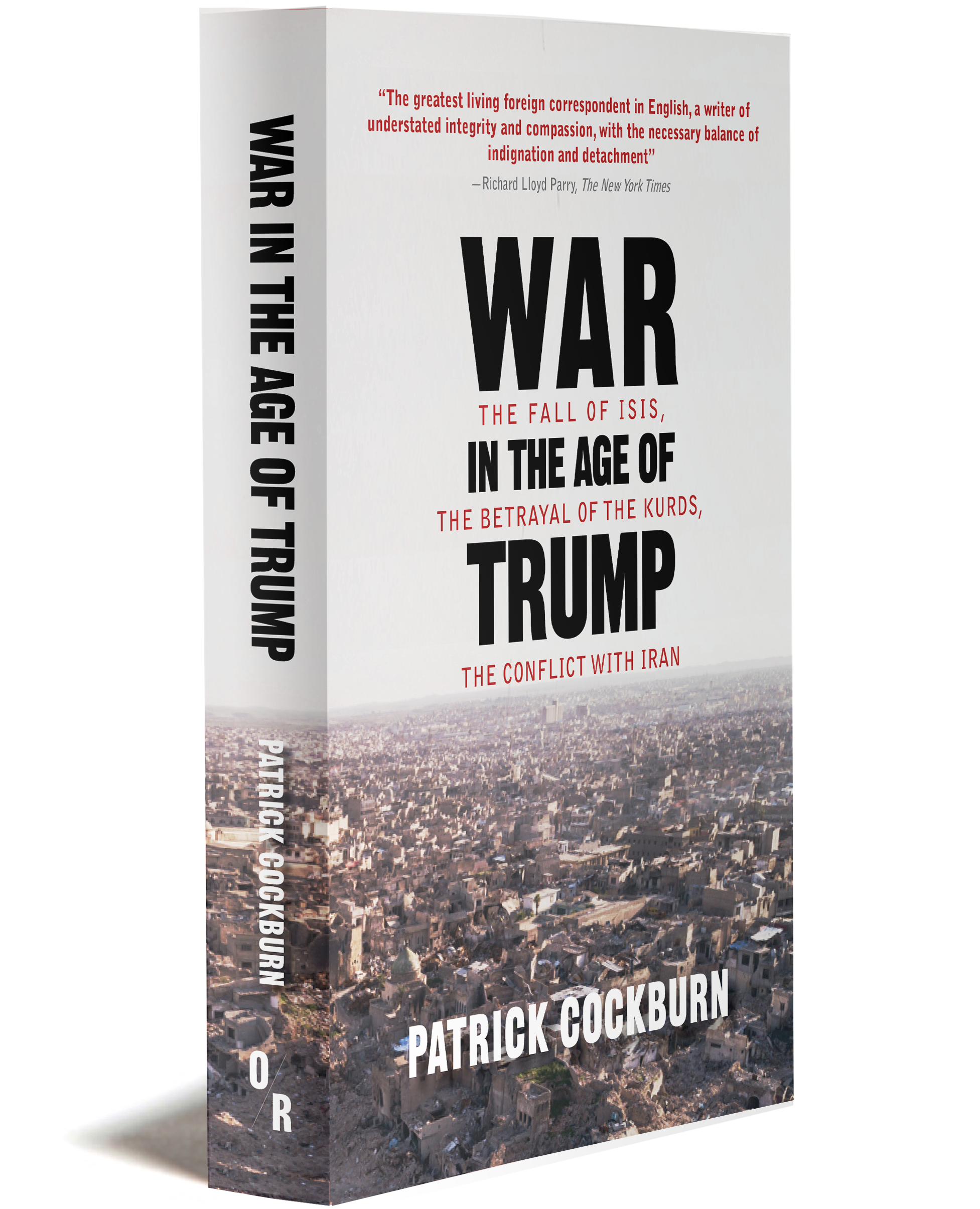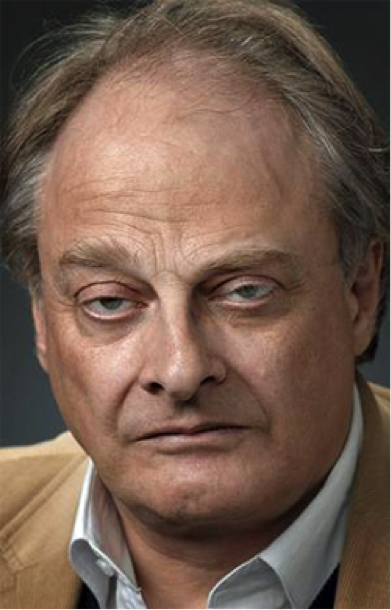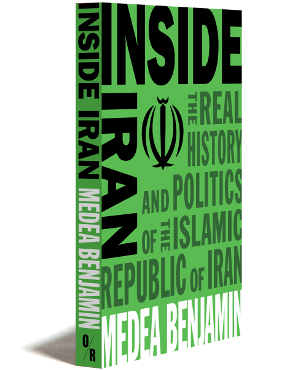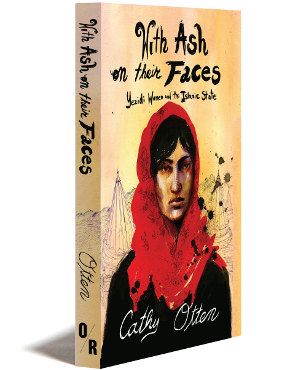
War in the Age of Trump
THE FALL OF ISIS, THE BETRAYAL OF THE KURDS, THE CONFLICT WITH IRAN
“The greatest living foreign correspondent in English, a writer of understated integrity and compassion, with the necessary balance of indignation and detachment” —Richard Lloyd Parry, New York Times
“Quite simply, the best Western journalist at work in Iraq today.” —Seymour Hersh
“One of the most accurate and intrepid journalists in Iraq.” —Sidney Blumenthal
“Has anyone covered this nightmare [in the Greater Middle East] better than the world’s least embedded reporter, Patrick Cockburn? Not for my money. He’s had the canniest, clearest-eyed view of developments in the region for years.” —Tom Engelhardt, TomDispatch
“Patrick Cockburn spotted the emergence of ISIS much earlier than anybody else and wrote about it with a depth of understanding that was just in a league of its own. Nobody else was writing that stuff at that time, and the judges wondered whether the Government should consider pensioning off the whole of MI6 and hiring Patrick Cockburn instead. The breadth of his knowledge and his ability make connections is phenomenal.” —Judges of the Foreign Affairs Journalist of the Year Award 2014
Tweet
About the Book
In this successor to his bestselling The Rise of Islamic State, which was translated into 16 languages, and the widely-acclaimed The Age of Jihad, prize-winning foreign correspondent Patrick Cockburn provides a clear-sighted and closely-observed account of the Middle East wars conducted by Donald Trump during the first term of his presidency.
From interviews via a weak cellphone link with soon-to-be killed Iraqis in Isis-besieged Mosul, to the gunshots heard in his Iraqi hotel room, not far from Tahrir Square where protests were swelling into a brutally-repressed national uprising; from the destruction of Raqqa, Afrin, and Eastern Ghouta, to Turkey’s ethnic cleansing of Kurds in north-east Syria, Cockburn opens a vivid window onto the end of the Isis Caliphate, the successive defeats of the Kurds, and America’s escalating confrontation with Iran, culminating in the world-shaking assassination of General Qasem Soleimani.
Donald Trump claimed that his would be a presidency that brought to an end American engagement in “messy” foreign wars. In this vital and necessary book, Patrick Cockburn exposes how his on/off adventurism has not only continued widespread intervention, but added a dangerous layer of chaos and unpredictability.
324 pages • Paperback ISBN 978-1-68219-236-8 • E-book 978-1-68219-239-9
About the Author

Patrick Cockburn is currently Middle East correspondent for the Independent, writes regularly for the London Review of Books and worked previously for the Financial Times. His books on war and peace in the Middle East include The Age of Jihad, The Rise of Islamic State, Muqtada al-Sadr and the Struggle for Iraq, The Occupation, as well as a memoir, The Broken Boy and, with his son Henry, a book on schizophrenia, Henry’s Demons, which was a finalist for the Costa Award. He won the Martha Gellhorn Prize in 2005, the James Cameron Prize in 2006, the Orwell Prize for Journalism in 2009, the Foreign Commentator of the Year in 2013, and the Foreign Affairs Journalist of the Year Award 2014.
Read an Excerpt
TAHRIR SQUARE, BAGHDAD
I was in Baghdad on the evening of 1 October 2019, staying at the Baghdad Hotel near Tahrir Square in the city centre. I was planning to visit Diyala governorate, north of Baghdad, the following day. The area had once been an Isis stronghold, and I wanted to see whether it was making a comeback. From my hotel I heard the distant sound of shots. They could have been in celebration of a wedding, or victory in a football match, but the gunfire went on too long for those things to make sense, so I went down to the lobby to find out what was happening. As I reached the front door a man came in from the street to say that the security services were shooting at protesters; ten of them had been killed. Later in the evening, I got in touch with a doctor at Medical City, a hospital complex not far from Tahrir Square, who said that ten dead was an underestimate and that he himself had seen four bodies. Meanwhile, the government was claiming a death toll of one.
Nobody had been expecting violence. By Baghdad standards it was a small protest—some 3,000 people on the streets—and it was motivated by social and economic issues: unemployment, government corruption, and inadequate electricity and water supply. I had been told about it the previous day by a group of young men demonstrating opposite the foreign ministry, where they were demanding jobs appropriate to their status as university graduates. They said they had been camped out there for forty-three days and were intending to go to the rally in Tahrir Square, but they didn’t seem to be expecting trouble. Street protests have become a familiar part of Iraqi politics over the last few years. In 2016, demonstrators broke into the Green Zone and ransacked parliament and the prime minister’s office. Last year in Basra, protests over water and electricity shortages led to the setting ablaze of government and party offices, though only twelve people were reported killed.
Last month in Baghdad, the response of the security forces was very different. And, as it turned out, not only of the security forces: also patrolling the streets were the pro-Iranian factions of the predominantly Shia paramilitary Hashd al-Shaabi, or Popular Mobilisation Units. When the protesters tried to cross the al-Jumhuriya bridge leading from Tahrir Square towards the Green Zone, they were met with live fire.
The next day I drove through Tahrir Square, where protesters and soldiers were eyeing each other nervously during a lull in the demonstrations. A man was lying on the pavement on a slip road leading up to the square, but I couldn’t see whether he was injured or dead. Shortly afterwards the government declared a twenty-four-hour curfew in Baghdad, a city of seven million people, as well as in towns and cities in the overwhelmingly Shia southern part of Iraq. It cut off access to the internet in the hope of making it impossible to organise protests—but the effect was that smaller rallies began popping up all over Baghdad. My contact in Medical City reported that his hospital had been invaded by pro-Iranian Shia paramilitaries—members of either Kata’ib Hezbollah or Asa’ib Ahl al-Haq—who were beating injured protesters as they lay in their beds. He complained to one of the paramilitary commanders, who hit him with a baton and told him to mind his own business.
News of the protests was being broadcast by local media. In an attempt to put an end to the publicity, members of a group called Saraya Talia al-Khurusani invaded TV stations, wrecking studios and smashing equipment. In the streets, riot police fired heavy-duty tear gas grenades directly at protesters, inflicting serious and in some cases fatal injuries. According to surgeons who treated the wounded, paramilitary snipers were aiming for the head or chest. The government announced that these tactics were prohibited and would not be repeated—but it was clearly no longer in control of the way the protests were being policed. The use of maximum force proved counterproductive, since over the next few days the demonstrations gathered in size, but whoever was issuing the orders was apparently determined that this was the only way to deal with them.
That person was reportedly the Iranian general Qasem Soleimani, head of Iran’s elite al-Quds Brigade.
In the Media
- “The West’s ‘Triumphalism’ in Ukraine Could Prolong Conflict Indefinitely” — WAR IN THE AGE OF TRUMP author Patrick Cockburn speaks with Democracy Now! (6/8/2022)
- “War, News and Chaos in the Middle East” — WAR IN THE AGE OF TRUMP author Patrick Cockburn interviewed on On Contact (10/30/2021)
- “Afghanistan: A nation abandoned?” — WAR IN THE AGE OF TRUMP author Patrick Cockburn speaks to The Independent (9/9/2021)
- “Joe Biden wants to avoid the Israeli-Palestinian conflict – but that won’t be an option for much longer” — WAR IN THE AGE OF TRUMP author Patrick Cockburn writes for the Independent (5/18/2021)
- “Escalating violence in Israel” — WAR IN THE AGE OF TRUMP author Patrick Cockburn interviewed on the Pat Kenny Show (5/14/2021)
- “After IS” — WAR IN THE AGE OF TRUMP author Patrick Cockburn writes for the London Review of Books (1/28/2021)
- “The damage Trump has done to America will be hard to undo” — WAR IN THE AGE OF TRUMP author Patrick Cockburn writes for the Independent (1/22/2021)
- “With Biden in the White House, do you foresee any major US policy changes?” — WAR IN THE AGE OF TRUMP author Patrick Cockburn interviewed for the New Left Review (1/15/2021)
- “There is more to fake news than Trump’s lies. Real journalists are needed more than ever” — WAR IN THE AGE OF TRUMP author Patrick Cockburn writes for the Independent (1/4/2021)
- “State sponsored assassinations in foreign countries are becoming the new norm” — WAR IN THE AGE OF TRUMP author Patrick Cockburn writes for the Independent (12/11/2020)
- “Trump’s worst crime must not be forgotten—ensuring the ethnic cleansing of Kurdish allies in Syria” — WAR IN THE AGE OF TRUMP author Patrick Cockburn writes for the Independent (12/4/2020)
- “America and Britain are the big losers on the world stage as they fail to control Covid” — WAR IN THE AGE OF TRUMP author Patrick Cockburn writes for the Independent (11/24/2020)
- “Trump’s cult of personality will be badly damaged by defeat—even if his toxic politics march on.” — WAR IN THE AGE OF TRUMP author Patrick Cockburn writes for the Independent (11/9/2020)
- “Even if defeated, Trumpism will not vanish” — WAR IN THE AGE OF TRUMP author Patrick Cockburn writes for the Independent (11/6/2020)
- “Wars and pandemics produce the same sort of lethal government bungling” — WAR IN THE AGE OF TRUMP author Patrick Cockburn writes for the Independent (10/16/2020)
- “The Assange extradition case is an unprecedented attack on press freedom—so why’s the media largely ignoring it?” — WAR IN THE AGE OF TRUMP author and IN DEFENSE OF JULIAN ASSANGE contributor Patrick Cockburn writes for the Independent (10/9/2020)
- “The next Gaza Strip? Daily battle of survival for those left in Idlib” — WAR IN THE AGE OF TRUMP author Patrick Cockburn writes for the Independent (10/9/2020)
- “Coronavirus, corruption, ISIS and politics — Iraq battered by perfect storm of crises” — WAR IN THE AGE OF TRUMP author Patrick Cockburn writes for the Independent (9/25/2020)
- “To Isolate or to Intervene?” — WAR IN THE AGE OF TRUMP author Patrick Cockburn interviewed on Parallax Views (9/11/2020)
- “For anyone interested in the Middle East… Essential reading.” — WAR IN THE AGE OF TRUMP reviewed by the Times (8/24/2020)
- “An accessible, often engrossing, introduction to the ongoing conflicts in the Middle East.” — WAR IN THE AGE OF TRUMP reviewed by Peace News (8/24/2020)
- “Must-read… An insightful account of how the aggressive policies promoted by President Trump are destabilising the [Middle East].” — WAR IN THE AGE OF TRUMP reviewed by Morning Star (8/24/2020)
- “A well-placed critique of both an inept presidency and an uncritical media.” — WAR IN THE AGE OF TRUMP reviewed by Kirkus Reviews (8/24/2020)
- “A nuanced, deeply informed account of recent events in the Middle East.” — WAR IN THE AGE OF TRUMP reviewed by Publishers Weekly (8/24/2020)
- “Iran-Iraq War: How a forgotten conflict still shapes Middle East politics to this day” — WAR IN THE AGE OF TRUMP author Patrick Cockburn writes for the Independent (8/20/2020)
- “We have to fight for the truth in wars and pandemics” — WAR IN THE AGE OF TRUMP author Patrick Cockburn writes for AlterNet (8/7/2020)
- “Trump is running against Biden—and the virus” — WAR IN THE AGE OF TRUMP author Patrick Cockburn writes for the Independent (7/28/2020)
- “Churchill’s secret chemical war” — WAR IN THE AGE OF TRUMP author Patrick Cockburn writes for the Independent (7/27/2020)
- WAR IN THE AGE OF TRUMP author Patrick Cockburn interviewed for Interzine (7/22/2020)
- WAR IN THE AGE OF TRUMP author Patrick Cockburn interviewed on ABC Radio National Late Night Live (7/21/2020)
- WAR IN THE AGE OF TRUMP author Patrick Cockburn interviewed on Radio War Nerd (subscribers only) (7/21/2020)
- “The UK and US are starting a new Cold War with Russia and China—so what are these governments trying to hide?” — WAR IN THE AGE OF TRUMP author Patrick Cockburn writes for the Independent (7/20/2020)
- “The Impact of the Assassination of General Qasem Soleimani” — WAR IN THE AGE OF TRUMP author Patrick Cockburn interviewed on Forthright Radio (7/2/2020)
- “The blundering British political class has shown the same incompetence in both fighting wars and coronavirus” — WAR IN THE AGE OF TRUMP author Patrick Cockburn writes for the Independent (6/30/2020)
- “Seeing Boris Johnson seeking to cope with the pandemic has become more and more like watching Peter Sellers play Inspector Clouseau in the Pink Panther films” — WAR IN THE AGE OF TRUMP author Patrick Cockburn writes for CounterPunch (6/24/2020)
- “Iraq’s new prime minister faces a host of challenges. Coronavirus is just one of them” — WAR IN THE AGE OF TRUMP author Patrick Cockburn writes for the Independent (6/17/2020)
- “The jokes in parliament prove British leaders have no idea how bad slavery was—and why people are protesting” — WAR IN THE AGE OF TRUMP author Patrick Cockburn writes for the Independent (6/15/2020)
- “The Cynical Forces Behind America’s Forever Wars” — WAR IN THE AGE OF TRUMP author Patrick Cockburn interviewed on Scheer Intelligence (6/12/2020)
- “Today Ellsberg is celebrated as the patron saint of whistleblowers while Assange is locked in a cell in London’s Belmarsh maximum security prison for 23 and a half hours a day” — WAR IN THE AGE OF TRUMP author and IN DEFENSE OF JULIAN ASSANGE contributor Patrick Cockburn writes for the London Review of Books (6/11/2020)
- “Defeat ISIS, betray the Kurds, murder the Iranian military mastermind—what does it add up to?” — WAR IN THE AGE OF TRUMP author Patrick Cockburn interviewed on Here & There (6/9/2020)
- “On the Rise and Fall of ISIS” — WAR IN THE AGE OF TRUMP excerpt published in Lit Hub (4/27/2020)





